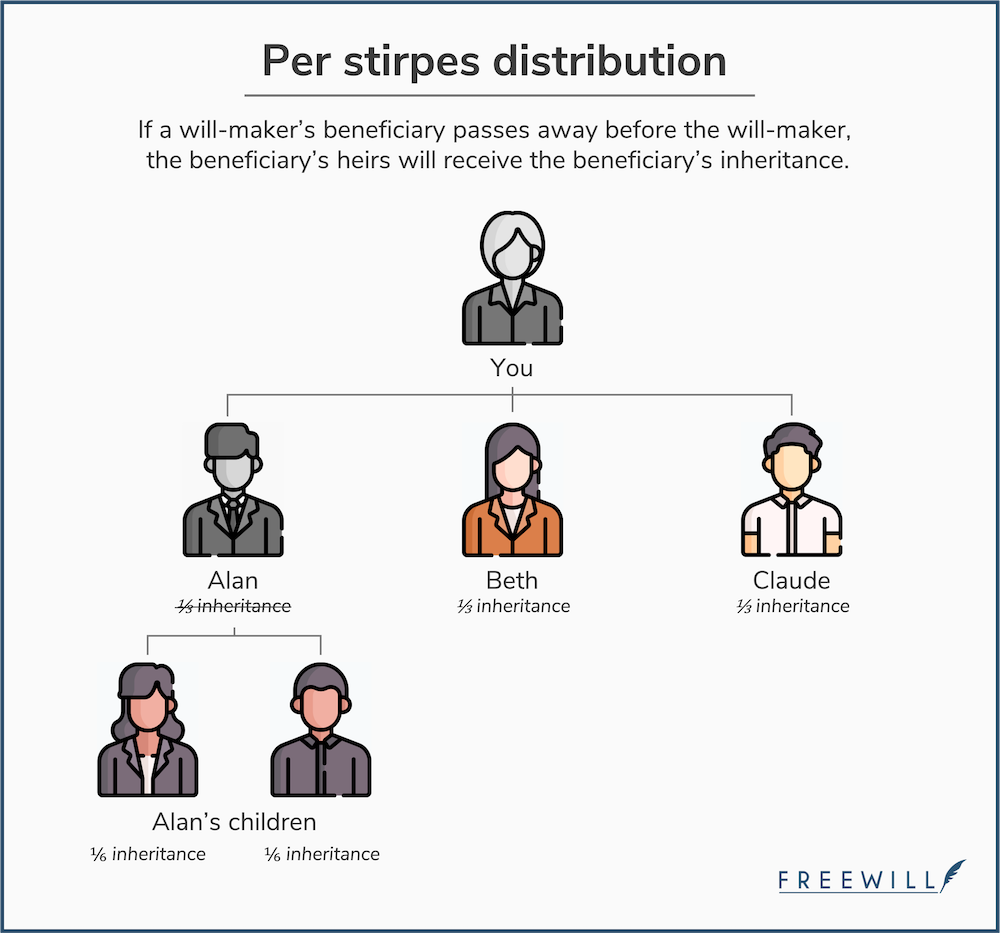As you move through your life, you’ve probably already thought about who you want to receive pieces of your property when you pass away: my spouse will keep the house, my children will get my books, and so on. But when you plan your estate, it’s important to think about who should be the “back-up” beneficiary to receive each of those assets. One way to streamline this decision is to use a per stirpes distribution.
What does per stirpes mean?
Per stirpes is a Latin term you can include in your last will and testament to explain who will inherit your assets if one of your beneficiaries passes away before you do. With a per stirpes distribution, if one of your beneficiaries dies before you, their share of your estate will pass to their descendants. Using per stirpes is a quick way to name contingent beneficiaries for your property.
For example, say you have three children — Alan, Beth, and Claude — and when you die you want to split your estate equally among them. But Alan passes away before you, leaving behind two children of his own. If you use a per stirpes distribution, then Alan’s children will inherit Alan’s portion of your estate in equal shares. In this example, Alan’s children each receive one-sixth of your estate, while Beth and Claude receive their one-third.

A per stirpes distribution only passes assets on to lineal descendants. Lineal descendants are direct descendants of a beneficiary (like children and grandchildren). Per stirpes doesn’t apply to other relatives of a beneficiary — like their parents or siblings. Think of it this way: a per stirpes distribution flows down a beneficiary’s family tree, not up.
Why use a per stirpes distribution in a will?
Using a per stirpes distribution in your will can save you time and simplify your estate planning. By using per stirpes, you don’t have to name contingent beneficiaries for every possible scenario. It also ensures that there are clear instructions for who should inherit your property, even if one of your primary beneficiaries passes away before you.
In some will templates and forms, you may see the phrase “by right of representation” instead of per stirpes. They mean the same thing and can be used interchangeably. If you create your will using FreeWill’s will-making tool, you’ll notice we use the language “by right of representation.”
Legal terms like per stirpes can be confusing. That’s why FreeWill also maintains a glossary of terms you may run into when making your will.
When shouldn’t you use a per stirpes distribution?
There may be some instances where a per stirpes distribution isn’t the best option for you. You may want to use another option if:
- You’d rather distribute your estate among only your remaining living beneficiaries. (This is known as a “per capita” distribution.)
- You want to name a completely new beneficiary if one of your primary beneficiaries passes away before you. (This secondary beneficiary is called a contingent beneficiary.)
- You’re part of a blended family. By law, only your biological or adopted children are legally considered your children — stepchildren are not. So if you have stepchildren or step-grandchildren, they can’t inherit via a per stirpes distribution. Using our previous example, let’s say only one of Alan’s children was his biological child, and his other was a stepchild. Only his biological child can receive assets under a per stirpes distribution.
- You think someone will contest your will. If you’re concerned one of your heirs may contest your will after you pass away, it may be a good idea to map out your primary and secondary beneficiaries. Using our previous example, you could write in your will that if Alan dies before you, then his two children will inherit his share of your estate in equal shares. You can also disinherit anyone you don’t want to receive assets from your estate. If it’s allowed in your state, you could also write a no-contest clause into your will.
How to use a per stirpes distribution in a will
To use a per stirpes distribution in your will, you should list each primary beneficiary’s full legal name and the property you want them to inherit. Then, you’ll include a line stating who you want to receive the assets if your beneficiary passes away before you.
Here’s an example: “I give to my son, Alan John Smith, one-third of my estate. If Alan John Smith does not survive me, this inheritance should be distributed to Alan John Smith’s descendants, per stirpes.”
To make it simple, you can use online will software to set your beneficiaries using a per stirpes distribution. If you use FreeWill to create your will, you simply fill out our questionnaire and list who you want to receive each of your assets. We’ll walk you through each step of the process and provide the appropriate legal language for you — resulting in a personal will document that reflects your wishes. And best of all, it’s completely free! Get started today.
Make your free estate plan today

Make your free advance healthcare directive

Make your free durable power of attorney

Make a stock donation today

Make your free revocable living trust










